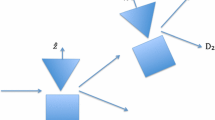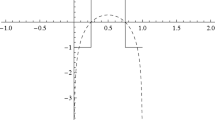Abstract
We will formulate two Bell arguments. Together they show that if the probabilities given by quantum mechanics are approximately correct, then the properties exhibited by certain physical systems must be nontrivially dependent on thetypes of measurements performedand eithernonlocally connected orholistically related to distant events. Although a number of related arguments have appeared since John Bell's original paper (1964), they tend to be either highly technical or to lack full generality. The following arguments depend on the weakest of premises, and the structure of the arguments is simpler than most (without any loss of rigor or generality). The technical simplicity is due in part to a novel version of the generalized Bell inequality. The arguments are self contained and presuppose no knowledge of quantum mechanics. We will also offer a Dutch Book argument for measurement type dependence.
Similar content being viewed by others
References
Aspect, A., J. Dalibard, and G. Roger.: 1982, ‘Experimental Tests of Bell's Inequalities using Time-Varying Analyzers’,Physical Review Letters 49, 1804–7.
Aspect, A., P. Grangier, and G. Roger.: 1981, ‘Experimental Tests of Realistic Local Theories via Bell's Theorem’,Physical Review Letters 47, 460–3.
Aspect, A., P. Grangier, and G. Roger.: 1982, ‘Experimental Realization of Einstein-Podolsky-Rosen-BohmGedankenexperiment, A New Violation of Bell's Inequalities’,Physical Review Letters 49, 91–4.
Belinfante, F. J.: 1973,A Survey of Hidden Variables Theories, Oxford.
Bell, J. S.: 1964, ‘On the Einstein-Podolsky-Rosen Paradox’,Physics 1, 195–200.
Bell, J. S.: 1966, ‘On the Problem of Hidden Variables in Quantum Mechanics’,Reviews of Modern Physics 38, 447–52.
Bell, J. S.: 1971, ‘Introduction to the Hidden Variable Question’, in B. d'Espagnat (ed.),Foundation of Quantum Mechanics, Academic Press, New York, pp. 171–81.
Bohm, D. and Y. Aharonov.: 1957, ‘Discussion of Experimental Proof for the Paradox of Einstein, Podolsky and Rosen’,Physical Review 108, 1070–6.
Bohm, D., and B. J. Hiley.: 1984, ‘Quantum Potential Model for the Quantum Theory’, in Kamefuchi et al. (eds.),Foundations of Quantum Mechanics in the Light of New Technology, Physical Society of Japan, Tokyo, pp. 231–2.
Bohr, N.: 1934,Atomic Theory and the Descriptive of Nature, Cambridge University Press.
Bohr, N.: 1935, ‘Can Quantum-Mechanical Description of Physical Reality be Considered Complete?’,Physical Review 38 696–702.
Cartwright, N.: 1989,Nature's Capacities and their Measurement, Clarendon, Oxford.
Clauser, J. F. and M. A. Horne.: 1974, ‘Experimental Consequences of Objective Local Theories’,Physical Review D10, 526–35.
Clauser, J. F. and A. Shimony.: 1978, ‘Bell's Theorem, Experimental Tests and Implications’,Reports on Progress in Physics 41, 1881–927.
Cushing, J. T. and E. McMullin (eds.).: 1989,Philosophical Consequences of Quantum Theory, Reflections on Bell's Theorem, University of Notre Dame Press.
Davies, P. C. W. and J. R. Brown (eds.).: 1986,The Ghost in the Atom, Cambridge University Press.
Einstein, A., B. Podolsky, and N. Rosen.: 1935, ‘Can Quantum-Mechanical Description of Physical Reality be Considered Complete?’,Physical Review 47, 777–80.
Healey, R.: 1979, ‘Quantum Realism: Naiveté Is No Excuse’,Synthese 42, 121–44.
Hellman, G.: 1982, ‘Einstein and Bell, Strengthing the Case for Microphysical Randomness’,Synthese 53, 445–60.
Hellman, G.: 1987, ‘EPR, Bell, and Collapse, a Route Around Stochastic Variables’,Philosophy of Science 54, 639–57.
Jarrett, J. P.: 1984, ‘On the Physical Significance of the Locality Conditions in the Bell Arguments’,Noûs 18, 569–89.
Jarrett, J. P.: 1989, ‘Bell's Theorem, A Guide to the Implications’, in Cushing and McMullin (1989), pp. 60–79.
Peacock, K.: 1991,Peaceful Coexistence or Armed Truce?, doctoral dissertation, University of Toronto.
Redhead, M. L. G.: 1987,Incompleteness, Nonlocality, and Realism, A Prolegomenon to the Philosophy of Quantum Mechanics, Clarendon Press, Oxford.
Shimony, A.: 1984, ‘Controllable and Uncontrollable Non-locality’, in Kamefuchi et. al., (eds.),Foundations of Quantum Mechanics in the Light of New Technology, Tokyo, Physical Society of Japan, pp. 225–30.
Stapp, H.: 1971, ‘S-Matrix Interpretation of Quantum Theory’,Physical Review D3, 1303–20.
Teller, P.: 1986, ‘Relational Holism and Quantum Mechanics’,British Journal for the Philosophy of Science 37, 71–81.
Teller, P.: 1989, ‘Relativity, Relational Holism and the Bell Inequalities’, in Cushing and McMullin (1989), pp. 208–23.
van Fraassen, B.: 1982, ‘The Charybdis of Realism, Epistemological Implications of Bell's Inequality’,Synthese 52, 25–38. Reprinted in Cushing and McMullin (1989), pp. 97–113.
Wigner, E.: 19?0, ‘On Hidden Variables and Quantum Mechanical Probabilities’,American Journal of Physics 33, 1005–9.
Author information
Authors and Affiliations
Rights and permissions
About this article
Cite this article
Hawthorne, J., Silberstein, M. For whom the Bell arguments toll. Synthese 102, 99–138 (1995). https://doi.org/10.1007/BF01063901
Issue Date:
DOI: https://doi.org/10.1007/BF01063901




